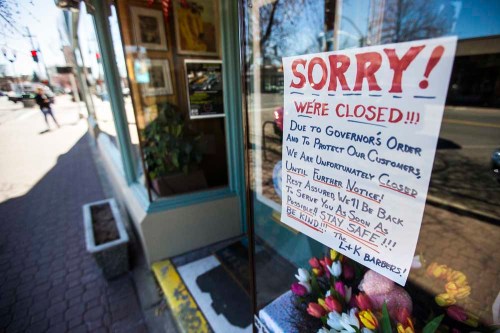Governor’s office proposes guidelines for reopening Oregon businesses
Published 1:00 pm Thursday, April 30, 2020

- A closed sign is posted in the front window of L & K Barber Shop in downtown Bend.
SALEM — Gov. Kate Brown hopes that some rural areas with few or no COVID-19 cases could start reopening for business and other activities as soon as May 15.
Brown held video conferences Friday afternoon with county and hospital officials in Central and Eastern Oregon to talk about testing, contact tracing and isolating of people infected with the coronavirus.
Trending
“Assuming these counties have these processes in place, that would enable us to safely and slowly begin the reopening process on May 15 for some counties — only if they meet all the criteria,” she said during a Friday morning press conference conducted by phone and video.
Brown said criteria would be released soon for counties that have had more than five COVID-19 cases. All of Oregon’s urban counties and some rural counties are in that situation.
“We’re not going to be able to reopen Oregon quickly or in one fell swoop,” Brown said, adding that Oregonians will still need to maintain physical distancing, wear masks in public and follow proper hygiene to prevent spreading the coronavirus. “Handshaking is probably out the window for a long time.”
She added, “I wish I could tell folks in Eastern Oregon that our lives are going to get back to normal. It is just going to be a different type of normal. And until we have a vaccine or we have medicine, we are going to have to be extremely careful regarding the virus.”
The Oregon Health Authority and Brown’s staff, working in consultation with advisory groups, has been drafting guidelines for how specific business sectors could reopen. As of Friday, medical, dental and veterinary facilities were allowed to resume regular procedures so long as they followed those rules.
Brown announced what she said was a thorough strategy to diagnose those who have COVOID-19 and to determine places where the coronavirus might be hiding. She said testing should be available throughout Oregon for anyone who displays COVID-19 symptoms, as well as to people in nursing homes, farmworker housing, prisons, fishing boats and other group living situations where the disease was suspected.
Trending
Public health officials will trace who came in contact with infected individuals. Anyone who did so will be asked to self-quarantine at home for 14 days.
In addition, Oregon Health & Science University will launch a year-long statewide study in which 100,000 Oregonians are selected at random and asked to volunteer for daily monitoring. Invitations to volunteer will be mailed out the week of May 11.
“In order to reopen and hopefully stay open, we must have randomized, widespread testing across the entire state,” Brown said. “This program is a game changer. It will give us a more accurate understanding of the true rate of infection in Oregon and to have ongoing precision monitoring of any new outbreaks.”
OHSU President Dr. Danny Jacobs said the data would help Oregon manage through the pandemic until a vaccine is developed. But he cautioned, “If we move too quickly in resuming our pre-COVID-19 lives, we put ourselves at increased risk of a secondary or second wave of infection.”
Dr. Dean Sidelinger, the state health officer, acknowledged the risks. “Our projections show that the disease will increase in Oregon as we open up, that more people will be hospitalized and even die,” he said.
Brown said the state would be ready to tighten restrictions if COVID-19 surged. Key metrics include the number of people going to hospital emergency departments for COVID-19 treatment, the average number of new cases and hospitalization rates.
The state’s major hospital systems — including Providence, Legacy, Kaiser, Asante, St. Charles and OHSU — have agreed that testing for the disease will be managed on a unified, statewide basis so every region has adequate resources. Brown said rural hospitals would be included.
Although the state has sufficient testing capacity overall, Oregon Health Authority documents show shortages in the central and southern Willamette Valley, along the central and southern coast, and in some of Eastern Oregon.
Harney, Umatilla, Baker and Douglas counties have submitted letters asking the governor for approval to reopen. Umatilla County Commissioner George Murdock said the Friday afternoon video conference with Brown left him feeling optimistic about a mid-May reopening.
“We don’t think our businesses can last much longer. They’re hanging on by a thread,” he said.
Murdock said officials were still seeking guidance about the feasibility of large gatherings, such as county fairs and the Pendleton Round-Up. Brown said that information would be forthcoming.









